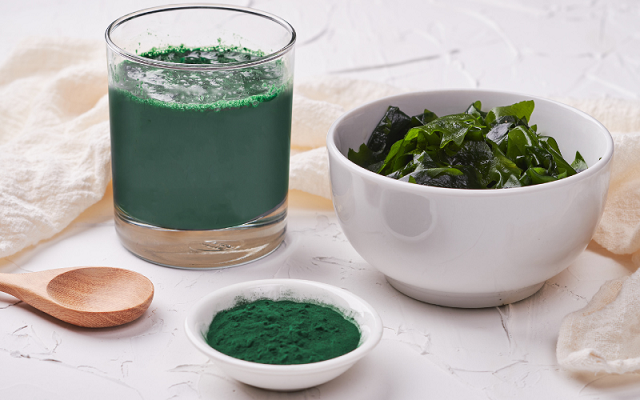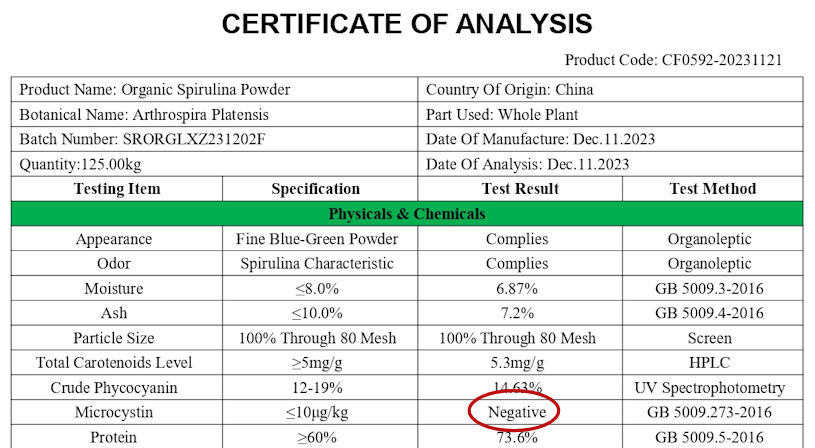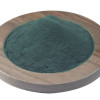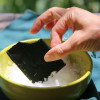Biovie has been selling organic spirulina for many years.
A person asked us about the potential presence of microcystins in our spirulina ponds. To answer this question, we will briefly review the benefits of spirulina and then explain how we ensure that the spirulina we offer is of the highest possible quality.
What are the benefits of spirulina ?
Organic spirulina, a blue-green microalga, is an excellent source of essential nutrients such as plant proteins, essential amino acids, essential fatty acids, chlorophyll, minerals, and various vitamins. It is a true superfood., particularly recommended in cases of iron deficiency. It is a high-quality nutritional supplement, To be consumed in small doses. .
With a protein content that can reach up to 60%, spirulina, named for its spiral shape, is an ideal option for vegetarians and vegans to meet their protein needs. Additionally, spirulina is rich in gamma-linolenic acid, an essential fatty acid beneficial for the skin, hair, and heart health.
The presence of high-quality chlorophyll in high concentration In spirulina, it contributes to its detoxification ability and its capacity to promote intestinal health. In addition to that, spirulina is an excellent source of minerals such as iron, magnesium, and calcium, as well as vitamins such as vitamin A, vitamin E, and vitamin K.
Furthermore, spirulina has antioxidant properties that help fight against damage caused by free radicals, as well as immune effects that strengthen the immune system. Studies have also confirmed the potential effects of spirulina in reducing blood pressure, modulating cholesterol levels, and alleviating allergy symptoms. In summary, spirulina offers a multitude of health benefits due to its nutritional composition and antioxidant properties.
What are the regulations concerning spirulina ?
The species of spirulina authorized for human consumption are Arthrospira platensis and Arthrospira maxima. Spirulina is cultivated in freshwater, generally in open ponds or under greenhouse conditions.
To ensure the safety of spirulina, it is crucial to source it from a vendor who is transparent about rigorous controls to detect and limit the presence of toxins and contaminants, as well as the risk of cross-contamination. This may include quality tests and analyses conducted on production waters to check for the presence of heavy metals, bacteria, and other undesirable substances.
Regulation thus plays an essential role in protecting spirulina consumers.
We market the organic quality spirulina in powder form (100% spirulina) imported by sea from Inner Mongolia, China since 2016, it is a reliable source that does not present any health risks due to the stringent monitoring of the produced batches. The controls carried out are rigorous, and paradoxically, importing forces us to conduct far more checks than for French production. We work with a carefully selected, trustworthy partner who has proven to be impeccable over the years. Regarding the controls and analyses of spirulina samples:
- Each batch of powdered spirulina that we import undergoes specific analyses for each lot: physical, chemical, microbiological, and heavy metals.
- At the time of importation during customs clearance or at other unpredictable times of the year without prior notice, public authorities, particularly the National Agency for Food Safety or the The Directorate for the Protection of Populations can take a sample of spirulina to have it analyzed by their independent laboratory.. In eight years, this has happened many times.
- Our spirulina being organic, Ecocert France conducts surprise inspections in our warehouse. from Vitrolles.

Microcystins: a contaminant that can be present in various foods
Microcystins are toxins produced by certain species of cyanobacteria (blue-green algae), which can contaminate water and food. The main sources of microcystin contamination include:
Contaminated fresh water Water from lakes, reservoirs, or rivers contaminated by cyanobacterial blooms can exceed the threshold of microcystins considered dangerous. If this water is used to irrigate crops, to water animals, or as a source of drinking water without adequate treatment, it can lead to contamination.
Fish and seafood Fish and other aquatic animals living in waters contaminated by microcystins can bioaccumulate these toxins in their tissues, particularly in the liver. Consuming these animals can therefore expose humans to these toxins.
Vegetables and crops irrigated with contaminated water Vegetables and other crops irrigated with water containing microcystins can absorb these toxins.
- Spirulina Spirulina can be contaminated by microcystins if the production method is not rigorous, if the batches are not properly controlled, and if the water source used to cultivate these algae is contaminated. The cultivation environment must be impeccable, and we ensure this at Biovie.
It is therefore important to understand that microcystins can develop in uncontrolled aquatic environments. Organisms such as Shellfish or fish accumulate and concentrate pollutants in their tissues., because shellfish filter water to feed and fish accumulate pollutants as they move up the food chain. Microalgae like spirulina can present contamination with microcystins, but they cannot accumulate microcystins like fish or shellfish.
The contamination levels of spirulina are generally much lower. to those of other common foods mentioned here. We use a supplier who produces spirulina in a perfectly controlled, monitored, and analyzed environment, and our spirulina has never contained microcystin.
Spirulina: prioritize the best-controlled supply chains
During the purchase of spirulina, it is essential to prioritize supply chains that are well-regulated and conduct systematic batch testing to ensure the quality and purity of the product. Productions that are too small or too artisanal may be less well-controlled. Organic certification guarantees a production process that is environmentally friendly and adheres to strict quality standards., as well as numerous additional control steps.
Do not hesitate to request the results of microbiological and microcystin analyses from your spirulina supplier to ensure the safety of the spirulina. These analyses help ensure that the product is free from contaminants and toxins that could potentially be harmful to health.








